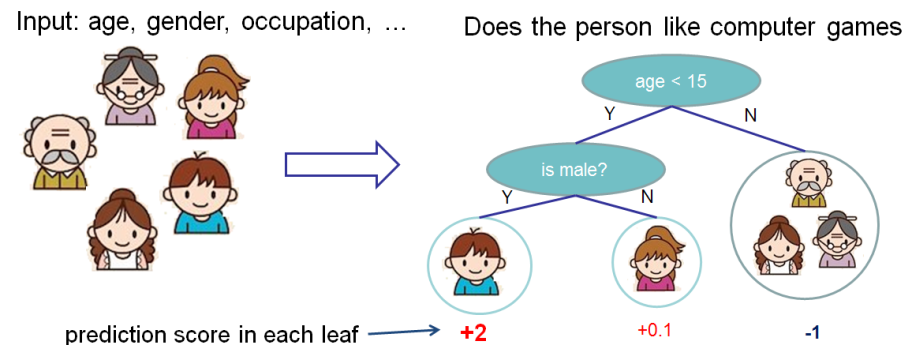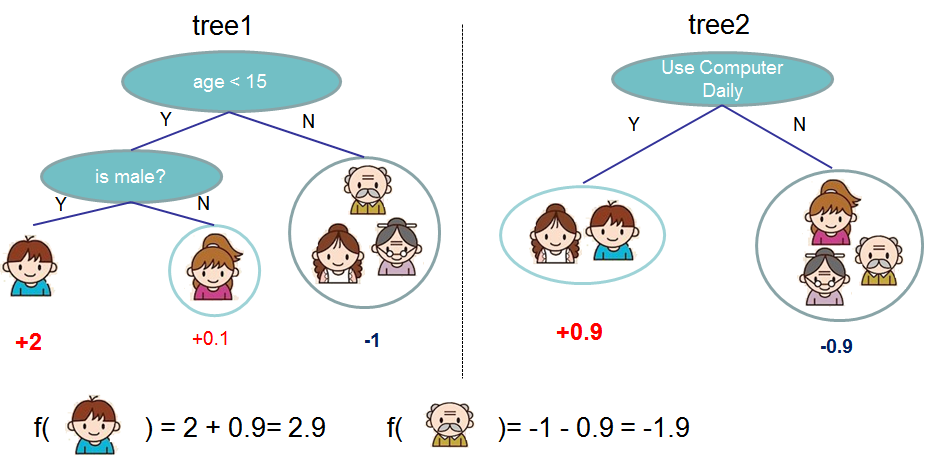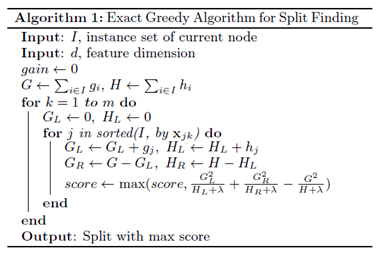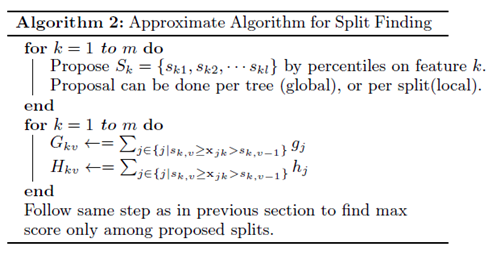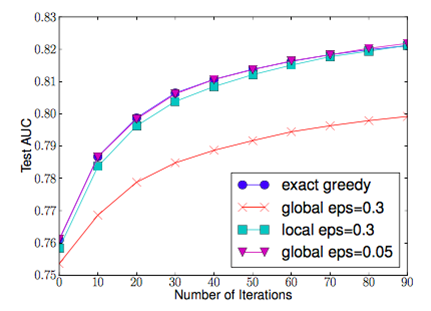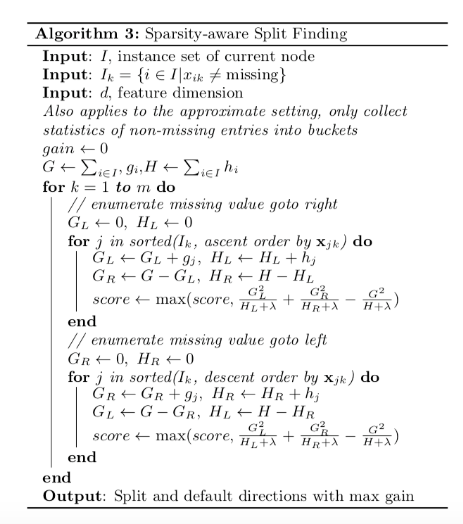XGBoost: A Scalable Tree Boosting System
Presented by
- Qianying Zhao
- Hui Huang
- Lingyun Yi
- Jiayue Zhang
- Siao Chen
- Rongrong Su
- Gezhou Zhang
- Meiyu Zhou
2 Tree Boosting In A Nutshell
2.1 Regularized Learning Objective
1. Regression Decision Tree (also known as classification and regression tree):
- Decision rules are the same as in decision tree
- Contains one score in each leaf value
2. Model and Parameter
Model: Assuming there are K trees [math]\displaystyle{ \hat y_i = \sum^K_{k=1} f_k(x_I), f_k \in Ƒ }[/math]
Object: [math]\displaystyle{ Obj = \sum_{i=1}^n l(y_i,\hat y_i)+\sum^K_{k=1}\omega(f_k) }[/math]
where [math]\displaystyle{ \sum^n_{i=1}l(y_i,\hat y_i) }[/math] is training loss, [math]\displaystyle{ \sum_{k=1}^K \omega(f_k) }[/math] is complexity of Trees
So the target function that needed to optimize is:[math]\displaystyle{ \sum_{i=1}^n l(y_i,\hat y_i)+\sum^K_{k=1}\omega(f_k), f_k \in Ƒ }[/math], where [math]\displaystyle{ \omega(f) = \gamma T+\frac{1}{2}\lambda||w||^2 }[/math]
For example:
Let's look at [math]\displaystyle{ \hat y_i }[/math]
[math]\displaystyle{ \hat y{i}^{(0)} = 0 }[/math]
[math]\displaystyle{ \hat y{i}^{(1)} = f_1(x_i)=\hat y_i^{(0)}+f_1(x_i) }[/math]
[math]\displaystyle{ \hat y{i}^{(2)} = f_1(x_i) + f_2(x_i)=\hat y_i^{(1)}+f_2(x_i) }[/math]
...
[math]\displaystyle{ \hat y{i}^{(t)} = \sum^t_{i=1}f_k(x_i)=\hat y_i^{(t-1)}+f_t(x_i) }[/math]
So [math]\displaystyle{ Obj^{(t)} = \sum_{i=1}^n l(y_i,\hat y_i^{(t)})+\sum^t_{i=1}\omega(f_i) }[/math]
=[math]\displaystyle{ \sum_{i=1}^n l(y_i,\hat y_i^{(t-1)}+f_t(x_i))+omega(f_t)+constant }[/math]
Take Taylor Expansion of the objective
[math]\displaystyle{ f(x+\delta x) \simeq f(x)+f^{'}(x)\delta x+\frac{1}{2}f^{''}(x)\delta x^2 }[/math]
then
[math]\displaystyle{ Obj^{(t)} = \sum^n_{i=1}[l(y_i,\hat y_i^{(t-1)})+g_if_t(x_i)+\frac{1}{2}h_i(x_i)]+\omega(f_t)+constant }[/math]
where [math]\displaystyle{ g_i =ə_{(\hat y_i)^{(t-1)}}(\hat y_i^{(t-1)}-y_i)^2 = 2(\hat y_i^{(t-1)}-y_i)h_i = ə^2_{(\hat y_i)^{(t-1)}}(\hat y_i^{t-1)}-y_i)^2 =2 }[/math]
Define [math]\displaystyle{ I_j={i|q(x_i)=j} }[/math] as the instance set of leaf j and [math]\displaystyle{ f_t(x_i)=w_j }[/math]. We can rewrite target function as follows
[math]\displaystyle{ Obj^{(t)} = \sum^{T}_{j=1}[(\sum_{i\in I_j} g_i)w_{j}+\frac{1}{2}(\sum_{i\in I_j}h_i + \lambda)w_j^2]+\gamma T }[/math]
The optimal weight [math]\displaystyle{ w^*_j }[/math] of node j is [math]\displaystyle{ w_j^*=\frac{\sum_{i\in I_j}g_i}{\sum_{i\in I_j}h_i+\lambda} }[/math]
The loss reduction after the split is given by
[math]\displaystyle{ Obj_{split}=\frac{1}{2}[\frac{(\sum_{i \in I_l} g_i)^2}{\sum_{i \in I_l} h_i+\lambda}+\frac{(\sum_{i \in I_R} g_i)^2}{\sum_{i \in I_R} h_i+\lambda}-\frac{(\sum_{i \in I} g_i)^2}{\sum_{i \in I} h_i+\lambda}]-\lambda }[/math]
3 Split Finding Algorithms
3.1 Exact Greedy Algorithm
Exact greedy algorithm is a split finding algorithm enumerates over all the possible splits on all the features. However, it is impossible to efficiently do so when the data does not fit entirely into memory.
The algorithm is following:
3.2 Approximate Algorithm
Due to limit computational memory and efficiency, the paper gives an approximate algorithm. The algorithm first proposes candidate splitting points according to percentiles of feature distribution, then it maps the continuous features into buckets split by these candidate points, aggregates the statistics and finds the best solution among proposals based on the aggregated statistics.
The global variant proposes all the candidate splits during the initial phase of tree construction, and uses the same proposals for split finding at all levels. The local variant re-proposes after each split.
From the figure above, the quantile strategy can get the same accuracy as exact greedy given reasonable approximation level.
3.3 Weighted Quantile Sketch
Data set splitting is one of the most important phase in the approximate algorithm. The most common approach is to split by feature’s percentile in order to obtain an uniform distribution of the selected data.
Formal, if we have the set
[math]\displaystyle{ D_k={(x_{1k},h_1),(x_{2k},h_2),...,(x_{nk},h_n)} }[/math]
We can use the following function to rank:
[math]\displaystyle{ R_k(z) = \frac{1}{\sum_{(x,h) \in D_k} h} \sum_{(x,h) \in D_k, x\lt z} h, }[/math]
The objective is to search for split points {s_{k1}, s_{k2}, …, s_{kl}} such that
[math]\displaystyle{ |r_k(s_{k,j}) – r_k(s_{k,j+1})| \lt \epsilon, }[/math]
Where [math]\displaystyle{ \epsilon }[/math] is an approximation factor. In general, it should approximately have [math]\displaystyle{ \frac{1}{\epsilon} }[/math] splitting points.
3.4 Sparsity-aware Split Finding
In real life, the input x may often be quite sparse. Possible causes are:
1. Data set contains missing values
2. Large amount of zero entries
3. Artifacts of feature engineering (ex. One-hot encoding)
In order to solve the sparsity behavior in the data, it is proposed to create a default direction in each tree node, as shown below:
When a value in a tree node is missing, we can use the following algorithm to calculate the optimal direction to proceed:
This algorithm is also applicable to the situation where user can set a limit on the accepted value, and neglect the out-of-range value when calculating the score.
The figure below shows the result of the comparison between a basic implementation and the sparsity aware algorithm on a Allstate-10K dataset.
We can see that the sparsity aware algorithm performs 50 times better than the simple implementation.
